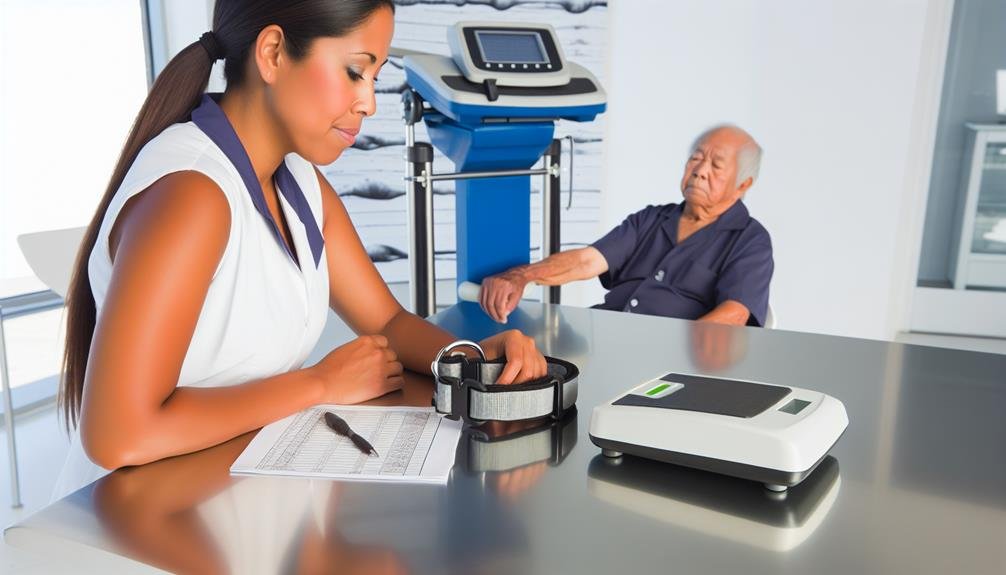
When it comes to safeguarding your well-being or that of a loved one, understanding what a Fall Risk Assessment entails is paramount. This assessment goes beyond just identifying potential fall risks; it involves a thorough evaluation of various factors that could contribute to an increased likelihood of falls. By grasping the significance of this assessment, you can take proactive steps to address vulnerabilities and enhance safety. Understanding the nuances of this process could truly make a difference in preventing avoidable accidents and ensuring a higher quality of life.
Key Takeaways
- Identifies susceptibility to falls through medical history and environmental analysis.
- Evaluates muscle weakness, balance issues, vision problems, and medication effects.
- Utilizes tools like the Morse Fall Scale and Timed Up and Go test.
- Tailors interventions to reduce fall risk and prevent injuries.
- Enhances safety, well-being, and quality of life, especially for the elderly population.
Definition of Fall Risk Assessment
To understand fall risk assessment, you must recognize it as a crucial process in identifying individuals’ susceptibility to falls. Fall risk assessment refers to the systematic evaluation of factors that may increase the likelihood of a person falling and getting injured. This assessment involves a comprehensive analysis of an individual’s medical history, current health conditions, medications, mobility issues, and environmental factors that could contribute to a fall.
The importance of fall risk assessment can’t be overstated. By conducting a thorough assessment, healthcare professionals can identify potential risk factors and implement appropriate interventions to prevent falls. This proactive approach not only helps in reducing the incidence of falls but also enhances the overall safety and well-being of individuals, especially the elderly population who are more vulnerable to fall-related injuries.
Purpose of Assessment
Understanding the purpose of fall risk assessment is essential for ensuring the safety and well-being of individuals at risk of falls. The primary purpose of conducting a fall risk assessment is to identify potential factors that may increase the likelihood of a fall occurrence. By assessing these risk factors, healthcare professionals can develop personalized interventions to reduce the risk of falls and prevent potential injuries. Additionally, fall risk assessments help in determining the level of care and supervision needed for individuals to maintain their independence while ensuring their safety.
To further understand the importance of fall risk assessments, let’s explore the key objectives and purposes through the following table:
| Purpose | Description |
|---|---|
| Identify Risk Factors | Recognize elements contributing to the potential of falls. |
| Personalize Interventions | Develop tailored strategies to mitigate fall risk. |
| Determine Care Level | Establish appropriate levels of care and supervision for individuals. |
| Prevent Injuries | Implement measures to prevent fall-related injuries. |
| Enhance Safety | Enhance the safety and well-being of individuals at risk of falls. |
Common Assessment Tools
Let’s talk about the POINTS related to common fall risk assessment tools.
These tools are crucial in helping healthcare professionals accurately evaluate an individual’s risk of falling.
Key Assessment Tools
When evaluating fall risk, utilizing common assessment tools like scoring systems and screening tools can provide valuable insights into your level of risk and assist in developing appropriate interventions.
Scoring systems such as the Morse Fall Scale or the Hendrich II Fall Risk Model help healthcare professionals quantify the risk level based on specific criteria.
Screening tools like the Timed Up and Go test or the Berg Balance Scale evaluate your physical abilities and balance, offering a practical assessment of your fall risk.
By undergoing these assessments, healthcare providers can tailor preventive strategies to address your individual needs effectively.
Understanding your risk level through these tools empowers you to take proactive steps in reducing the likelihood of falls.
Importance of Assessment
Discover how utilizing common assessment tools can empower you to proactively manage your fall risk level effectively.
The importance of assessment lies in identifying potential risks early on to implement necessary prevention measures. By utilizing tools like the Timed Up and Go Test or the Morse Fall Scale, you can gain valuable insights into your current fall risk status.
These assessments help healthcare providers tailor specific interventions to address your individual needs, ultimately reducing the likelihood of falls. Engaging in regular assessments not only allows for early detection of potential risks but also enables you to take proactive steps towards enhancing your safety and well-being.
Embracing these assessment tools is a crucial part of maintaining a proactive approach to fall prevention.
Accuracy in Assessment
To ensure accurate fall risk assessment, it’s essential to utilize common assessment tools such as the Timed Up and Go Test and the Morse Fall Scale. These tools are crucial in determining the risk of falls in individuals.
The reliability of an assessment tool refers to its consistency in measuring fall risk, while validity ensures that the tool measures what it intends to. Sensitivity in assessment indicates the tool’s ability to correctly identify those at risk of falling, while specificity highlights its capacity to correctly identify those not at risk.
Risk Factors Evaluated
When evaluating risk factors for falls, it’s crucial to consider common factors that can contribute to an increased risk. By assessing these key elements, healthcare professionals can better understand the potential for falls and implement appropriate interventions.
Utilizing specific assessment tools can aid in identifying and addressing these risk factors effectively.
Common Risk Factors
Identifying common risk factors is crucial in determining an individual’s susceptibility to falls. Some prevalent risk factors include muscle weakness, balance issues, vision problems, medication side effects, and environmental hazards.
Muscle weakness can make it harder to recover from a loss of balance, while balance problems increase the likelihood of stumbling. Vision impairments may lead to misjudging distances or obstacles. Certain medications can cause dizziness or drowsiness, contributing to falls. Environmental hazards like slippery floors or poor lighting pose additional risks.
Understanding these common risk factors allows healthcare professionals to tailor prevention strategies to address specific vulnerabilities, such as strength and balance exercises, medication reviews, vision screenings, and home safety assessments.
Assessment Tools Used
Understanding the assessment tools used is essential in evaluating the various risk factors that contribute to an individual’s susceptibility to falls. Healthcare professionals utilize a range of assessment tools to determine fall risk and implement appropriate fall prevention strategies and safety measures. Here is a table outlining some commonly used assessment tools:
| Assessment Tool | Description | Key Focus |
|---|---|---|
| Timed Up and Go Test | Evaluates mobility and balance while performing tasks | Physical function and fall risk |
| Morse Fall Scale | Identifies risk factors associated with falls | Fall risk assessment and prevention |
| Berg Balance Scale | Measures balance and risk of falling | Balance impairment and fall prevention |
| Hendrich II Fall Risk | Assesses fall risk in hospitalized patients | Medication side effects and fall risk |
| Fall Efficacy Scale | Explores fear of falling and self-efficacy | Confidence in performing daily activities |
These tools are crucial in developing personalized care plans tailored to each individual’s needs, ensuring effective fall prevention and safety measures.
Importance of Early Detection
Detecting fall risk early is crucial for implementing effective preventive measures and ensuring the safety of individuals. Early intervention plays a vital role in minimizing the likelihood of falls and related injuries. By identifying potential risk factors promptly, healthcare providers can tailor interventions to address specific needs, ultimately reducing the chances of falls occurring. This proactive approach not only safeguards individuals but also promotes overall well-being.
Through early detection, healthcare professionals can initiate timely assessments and interventions, such as strength and balance exercises, medication adjustments, or environmental modifications. These preventative measures are more impactful when implemented early, as they aim to address underlying risk factors before they escalate into serious issues. By being proactive in identifying fall risk, individuals can receive the necessary support and guidance to enhance their safety and quality of life.
Preventive Measures and Interventions
To enhance safety and reduce fall risk, consider implementing tailored preventive measures and interventions promptly. Fall prevention strategies are crucial in mitigating the risk of falls. Engage in patient education sessions to raise awareness about potential fall hazards and to promote proactive behaviors. Encouraging patients to stay active through personalized exercise programs can improve strength, balance, and coordination, thereby reducing the likelihood of falls.
Additionally, environmental modifications play a significant role in preventing falls. Conduct a thorough assessment of living spaces to identify and address potential fall risks, such as loose carpets, poor lighting, or cluttered walkways. Simple adjustments like installing grab bars in bathrooms or removing tripping hazards can make a substantial difference in preventing falls.
Conclusion
You’ve learned about the importance of fall risk assessments in preventing injuries and promoting safety for at-risk individuals.
Did you know that every 11 seconds, an older adult is treated in the emergency room for a fall-related injury?
By identifying and addressing risk factors early on, we can reduce the likelihood of falls and ultimately improve the well-being of those we care for.
Stay proactive and prioritize fall prevention in your healthcare practices.




